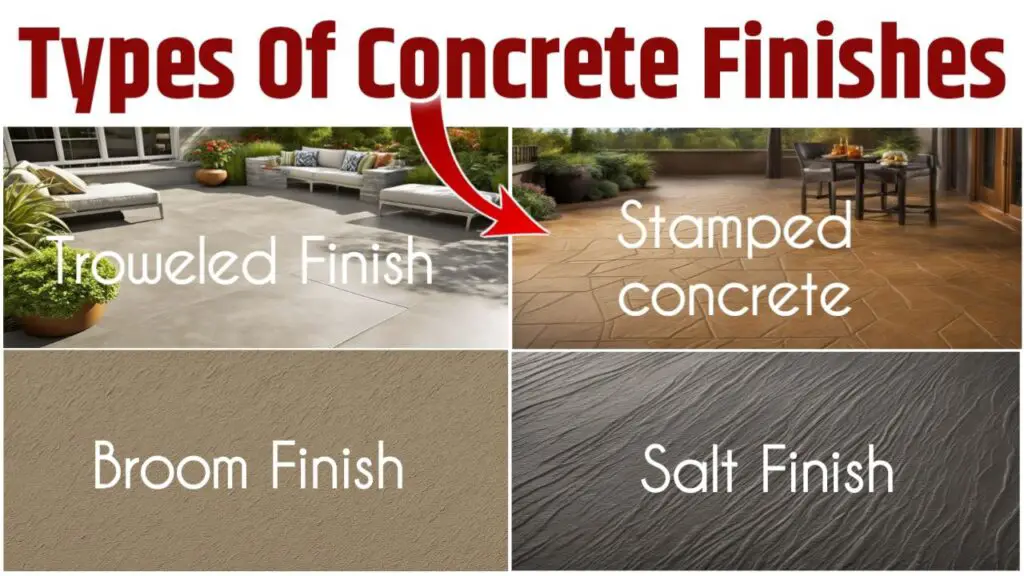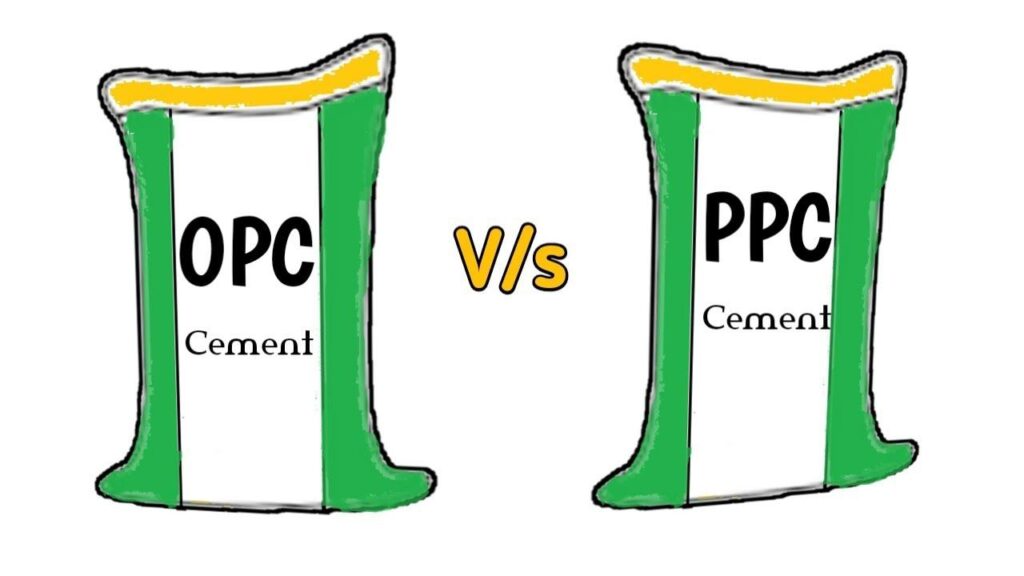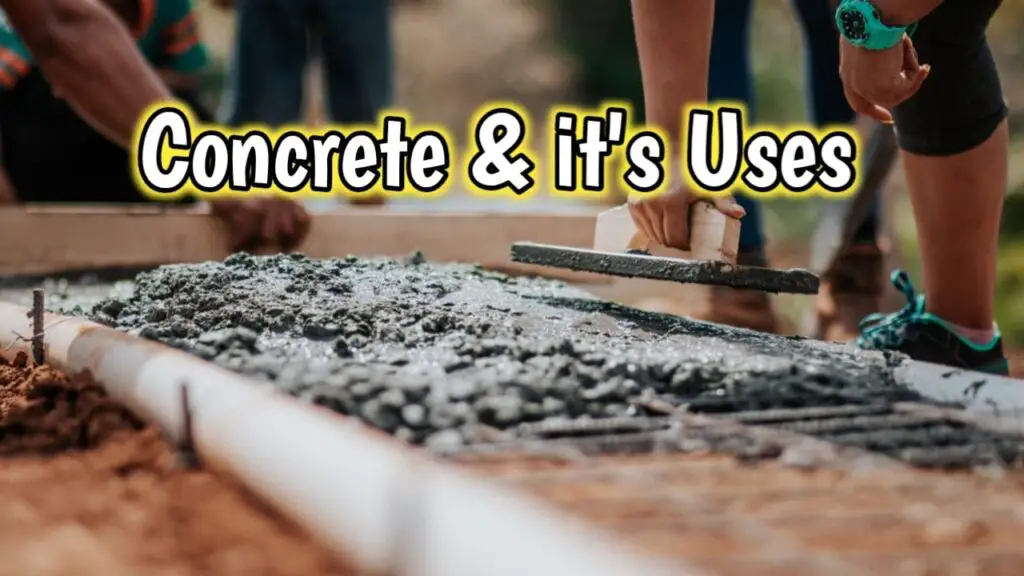Imagine a world where the concrete beneath our feet wasn’t the dull, grey slab we’re so accustomed to, but instead a canvas of endless possibility. This is the reality that concrete finishes have provided; according to the American Concrete Institute, more than 70% of concrete surfaces in residential and commercial settings now feature some finish.
The art of applying concrete finishes is not just about enhancing the material’s durability – it’s a blend of science and aesthetics that revamps plain concrete into eye-catching and functional masterpieces. My journey into the intricate world of concrete finishes will cover their myriad benefits like bolstering longevity and the value they add to spaces through visual appeal, juxtaposing these perks against the inevitable disadvantages that accompany such choices.
Whether it’s the simplicity of a troweled concrete finish, the practicality of a broom concrete finish, or the decorative allure of stamped concrete finishes, each type comes with its own set of advantages and disadvantages. The benefits of using concrete finishes are evident – from resistance to wear and tear, and boosting design aesthetics, to the long-term cost benefits. But as with any building material, they also present unique challenges and drawbacks which I will dissect thoroughly.
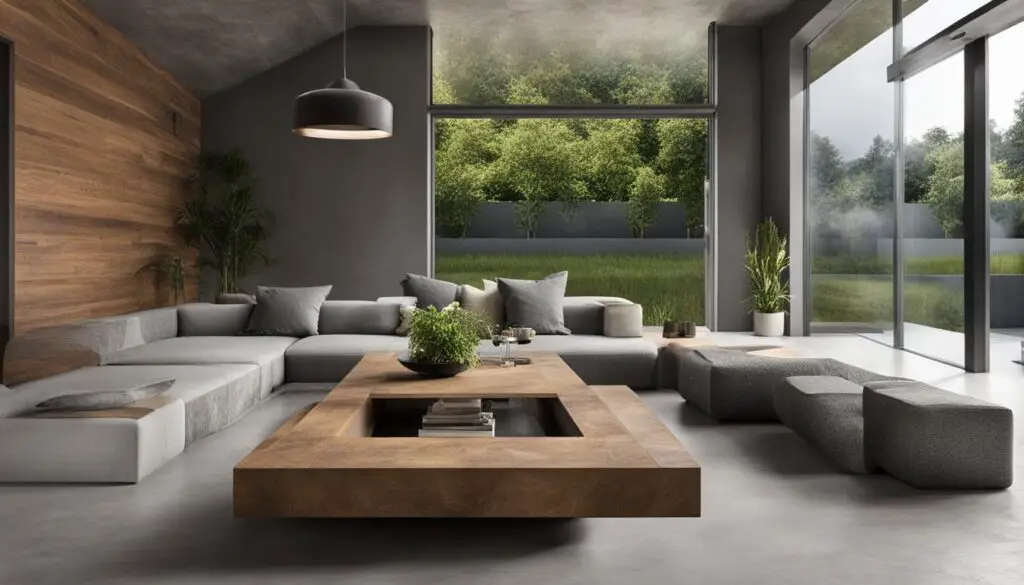
Key Takeaways
- Concrete finishes greatly expand the aesthetic potential and durability of concrete surfaces.
- The right finish can transform both the functionality and the visual impact of a space.
- Different finishes suit diverse environments, with each offering specific benefits and facing distinct drawbacks.
- Durability, maintenance, and aesthetic appeal are significant benefits of using concrete finishes.
- It’s essential to consider both the advantages and disadvantages of concrete finishes when planning a construction or renovation project.
- Artistic and decorative concrete finishes like stamped or swirled provide unique design options for customization.
- Economical concrete finish options can meet budgetary constraints while still enhancing the surface’s appeal.
Understanding Concrete Finishes and Their Importance
As I delve into the world of construction and design, my attention becomes steadily fixated on the importance of concrete finishes. These are not just mere aesthetic choices; they are the skin of our urban landscape that dictates performance and safety. In my exploration, informed by the insights from the American Concrete Institute and the National Ready Mixed Concrete Association, it’s become clear that understanding the different types of concrete finishes is crucial for any construction project.
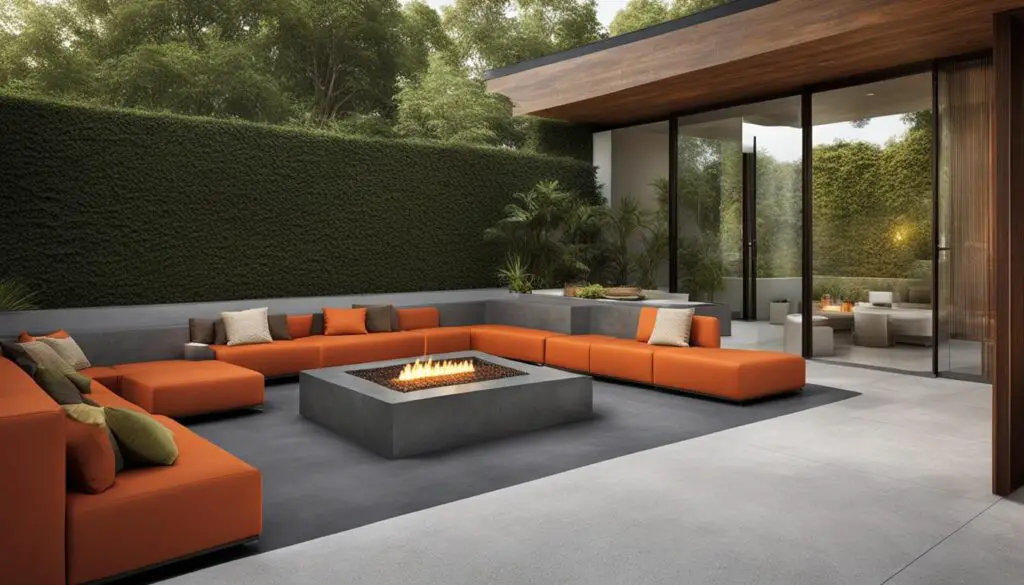
There’s an expansive range of finishes available, each fulfilling distinct roles that cater to the demands of varied environments. From the sleekness of polished concrete, designed for ease underfoot in bustling commercial spaces, to the rugged grip of a broom finish ensuring slip resistance around pool areas, concrete finishes intertwine functionality with style.
Let’s consider the multitiered impact of these finishes:
- They are integral in prolonging the lifespan of concrete and limiting the necessity of frequent repairs.
- Aesthetic flexibility offers architects and designers the expressive freedom to create spaces that resonate with the building’s identity and its surrounding context.
- From a safety perspective, specific finishes add essential texture that prevents falls and facilitates accessible movement.
The table below neatly encapsulates the primary functions that different concrete finishes serve:
| Finish Type | Functional Role | Aesthetic Influence | Safety Feature |
|---|---|---|---|
| Polished | Low-maintenance, reflects light | Sleek, modern look | Smooth but non-slip when treated |
| Broom | Durable for heavy outdoor traffic | Textured but uniform appearance | Enhanced traction, anti-slip |
| Stamped | Imitates other materials like stone | “Decorative pattern” ns and designs | Varied texture adds grip |
| Exposed Aggregate | Resistant to harsh weather | Reveals colorful stones within | Natural grip from stone texture |
The evidence supports concrete finishes as not just a choice but a necessity. The judicious selection of finishes can significantly alter the lifeline, safety, and visual appeal of constructed environments. I’m keenly aware that the right finish extends beyond aesthetics – it encapsulates the built environment’s functionality, user experience, and the harmonious blending of form and function.
Benefits of Using Concrete Finishes
As I examine the myriad uses of concrete within the construction industry, I’m constantly reminded of the substantial impact finishes can have on this ubiquitous material. Concrete finishes not only protect and extend the life of a structure but also offer a wealth of aesthetic and economic advantages that are essential for both property owners and builders. Join me as we delve into the benefits of using concrete finishes and discover how they contribute to building enduring and beautiful spaces.
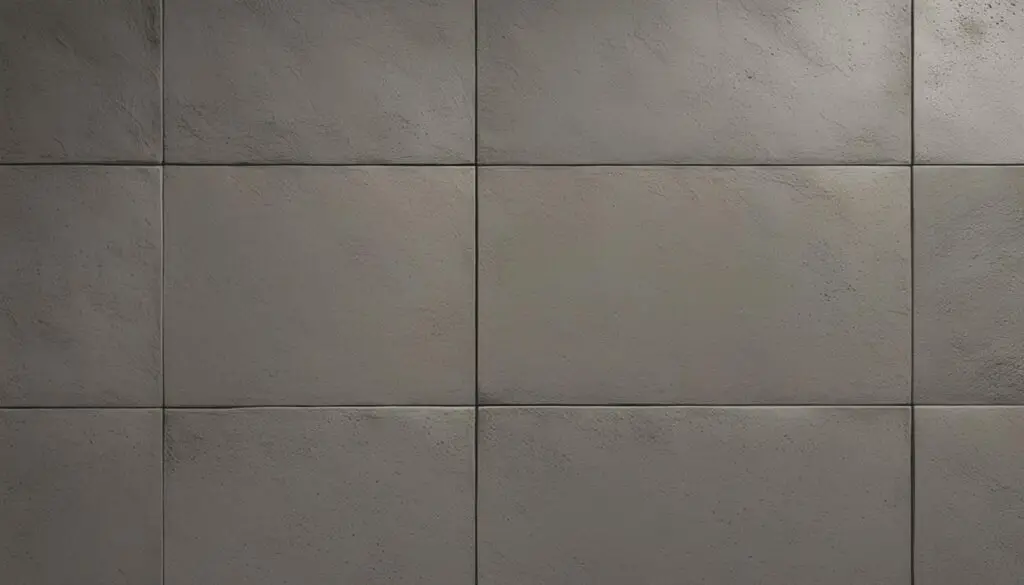
Improved Durability
The first advantage of concrete finishes that stands out is improved durability. There’s a compelling reason why finishes are highly recommended in areas expecting significant foot traffic or heavy load. Concrete may be tough in its bare form, but a finish can enhance resistance to wear and tear, weather conditions, and abrasions. For instance, a sealed concrete surface can prevent water, stains, and cracks from compromising the concrete’s integrity, thus ensuring longevity.
Enhanced Aesthetic Appeal
One cannot overlook the enhanced aesthetic appeal that concrete finishes bring to the table. It’s truly remarkable how a simple, gray surface can be transformed into a work of art with techniques like stamping, staining, or polishing. By employing different concrete finishes, architects, and designers have the freedom to elevate a space seamlessly, from creating rustic charm with a salt finish to providing a mirror-like sheen with diamond-polished concrete.
Maintenance and Long-Term Cost Benefits
Opting for a concrete finish can translate into long-term cost benefits due to its low maintenance needs. Imagine the reduced frequency of repairs or replacements, thanks to a wear-resistant surface. Finishes like sealing or epoxy coatings make cleaning spills and messes a breeze, further preserving the concrete. This longevity, coupled with minimal upkeep, positions concrete finishes as a cost-effective and sensible choice for long-term facility management.
In alignment with the durability and aesthetic enhancements, I’ve seen first-hand how the right finish can translate to tangible savings over a building’s lifecycle. The initial investment in a finish can offset potential future costs, confirming that the benefits of using concrete finishes are not only practical but also financially savvy. As we continue to innovate in concrete technology, it is clear that these finishes are no mere trend—they’re foundational elements that underpin our built environment’s future.
Troweled Finish: A Classic Choice
As I explore the vast landscape of concrete finishes, the troweled finish stands out as a testimony to the timeless class it brings to architecture. Renowned for its classic concrete finish, a troweled surface represents a seamless blend of durability and traditional aesthetics. The process involves expert craftsmen meticulously smoothing wet concrete with a trowel to create a smooth concrete surface that’s both visually appealing and highly functional.
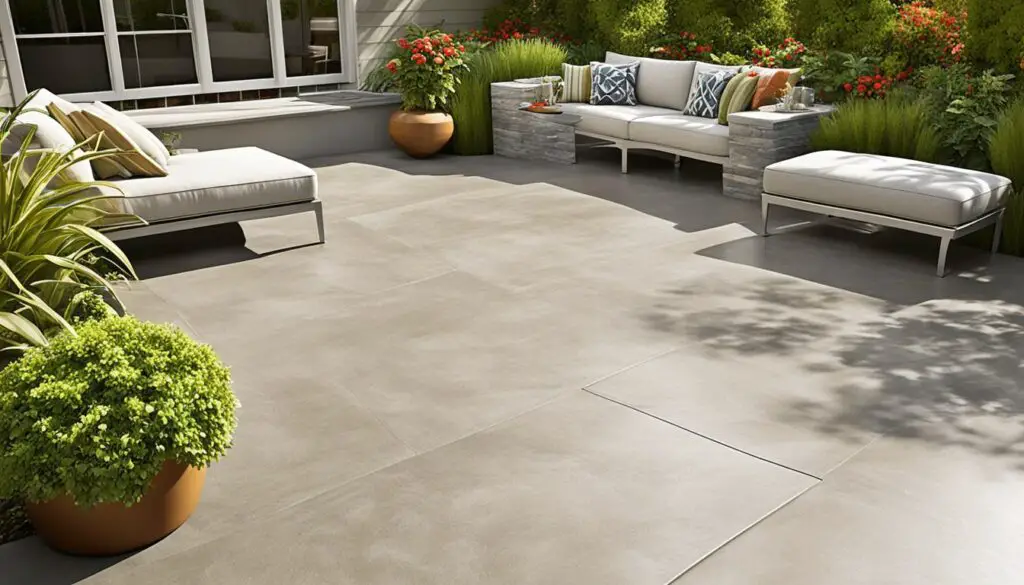
The elegance of a troweled finish is found in its simplistic ability to enhance both indoor and outdoor spaces. For interior applications, such as residential living rooms or corporate lobbies, a troweled finish offers a sleek and sophisticated base that complements various design elements. Meanwhile, in outdoor settings, like patios and garden pathways, this finish provides a sturdy yet appealing look that endures through changing seasons.
- Indoor Elegance: For those seeking a refined and polished look, the troweled finish is perfect for indoor surfaces, providing a pristine and uniform appearance.
- Outdoor Durability: In external applications, troweled finishes hold up against the elements, offering a resilience that’s necessary for outdoor enjoyment.
Let’s dive deeper into the specific places where the troweled finish is most prevalent:
| Location | Functionality | Aesthetic Quality |
|---|---|---|
| Residential Flooring | Easy to clean, exceptional longevity | Provides a neutral backdrop for decor |
| Commercial Lobbies | Withstands high foot traffic | Emanates professionalism and elegance |
| Patio Spaces | Resists weathering and frequent usage | Complements natural outdoor beauty |
| Garden Pathways | Prevents erosion, easy to navigate | Adds structural definition to landscaping |
A troweled finish not only responds to the demands for a classic concrete finish but also delivers on the promise of a durable, smooth concrete surface that exudes subtle refinement. As I reflect on the essence of this finish, it’s clear that its continued popularity is a nod to its ability not just to serve as a foundation but also to elevate the spaces it encompasses.
Broom Finish: Versatility for Outdoor Use
My investigation into the realm of concrete surfaces would be incomplete without highlighting the classic broom finish—widely recognized for its practicality and safety in outdoor environments. This utilitarian finish balances visual appeal with functionality, cementing it as a go-to for those seeking a nonslip surface.
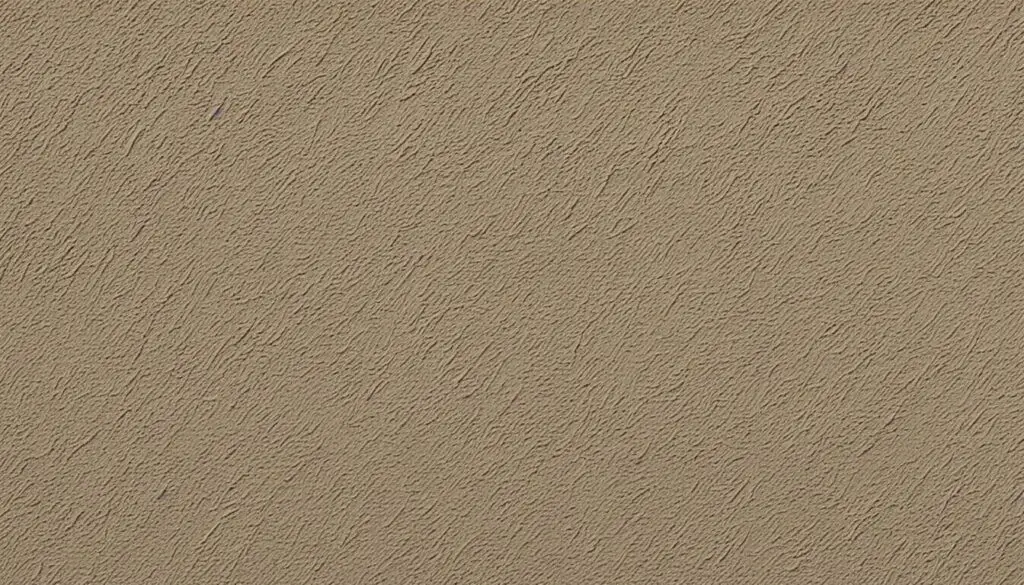
Description
Characterized by its simple application and textured appearance, a broom finish is achieved by pulling a broom over freshly laid concrete. This process creates fine ridges that provide a grip-friendly surface, making it safer to walk on, especially when wet. Its subtlety lies in the understated but functional texture that delivers a neat and non-skid finish to outdoor concrete surfaces.
Uses
In my professional experience, the broom finish has found favor across a diverse range of outdoor concrete applications. From public sidewalks to private patios, this finish is a staple for areas requiring dependable foot traction. Its widespread use includes:
- Residential driveways and walkways
- Public pavements and parking lots
- Pool decks where water-related slips are a concern
- Service areas and loading docks
Advantage
The primary advantage of broom finish lies in its ability to provide a secure, nonslip surface. As I’ve seen over the years, many homeowners and businesses prefer this practical concrete finish for its combination of safety and low-cost installation. Moreover, it requires minimal maintenance, enduring the test of time without losing its nonskid properties.
Disadvantage
Despite its numerous benefits, my observations have noted that the broom finish has limitations. The uniform texture, while practical, lacks the creative allure of more decorative concrete finishes, and may not suit the aesthetic design of every project. Additionally, the ridges can be challenging to clean thoroughly, as debris tends to settle within the grooves, requiring more attention than smootherconcrete finishes.
Stamped Concrete Finish: Artistic Patterns and Textures
As I veer into the realm of stamped concrete finish, it’s apparent that the aesthetic versatility it brings to the forefront of architectural design is groundbreaking. A quintessential example of artistic concrete, stamped concrete allows for the creation of rich textures and intricate patterns, all while maintaining the inherent strength and durability of traditional concrete surfaces. The capacity to simulate natural textures of stone, brick, or even wood, positions stamped concrete as an avant-garde option among decorative concrete finishes.
Nowadays, the intricacy and visual appeal of a patterned concrete surface are synonymous with luxury and creative expression in landscaping and building designs. With a plethora of design templates and coloration techniques available, stamped concrete provides an unmatched range of styles, from the rustic charm of cobblestone walkways to the elegant simplicity of slate terraces.
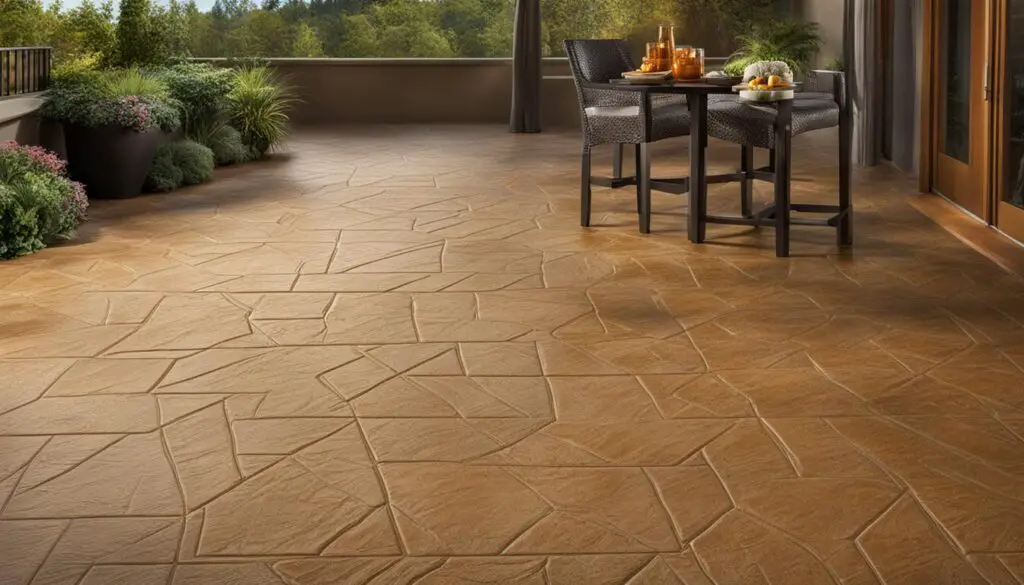
But the art of stamping concrete is about more than just aesthetics. It’s about how the interplay of shadows and hues can evoke sensory experiences reminiscent of natural materials. Yet, unlike the materials it often imitates, stamped concrete is applauded for its ease of maintenance and cost-effectiveness, being significantly less expensive than actual stone or wood paving.
Here’s a closer look at the places where stamped concrete has a profound impact:
- Patios: The go-to choice for homeowners desiring a high-end look without the high-end cost.
- Driveways: Provide a grand entrance to any property, enhancing curb appeal and property value.
- Public Spaces: City walkways, parks, and other communal areas benefit from the durability and artistic expression stamped concrete offers.
- Commercial Venues: Establishments such as restaurants and retail spaces utilize stamped concrete for its ability to draw in visitors through visual appeal.
The process involves pouring slab concrete and then impressing designs and textures onto the surface while it is still soft and workable. For this reason, each stamped concrete project can be viewed as a unique piece of handcrafted artistry, tailored to suit the client’s individual taste or to blend with the intrinsic character of the surrounding environment.
Albeit stamped concrete is lauded for its attractiveness and versatility, it’s imperative to understand that its installation requires expertise and precision to ensure the patterns are impeccably embossed and the color is evenly distributed. As such, enlisting skilled professionals who can realize the envisioned result is paramount.
Salt Finish: Distinctive Texture for Slip Resistance
My engagement with various concrete finishes has introduced me to the unique aesthetic and functional qualities of the salt finish. Especially pertinent in designs that call for slip-resistant concrete, a salt finish offers a textured concrete finish that is both practical and striking in appearance.
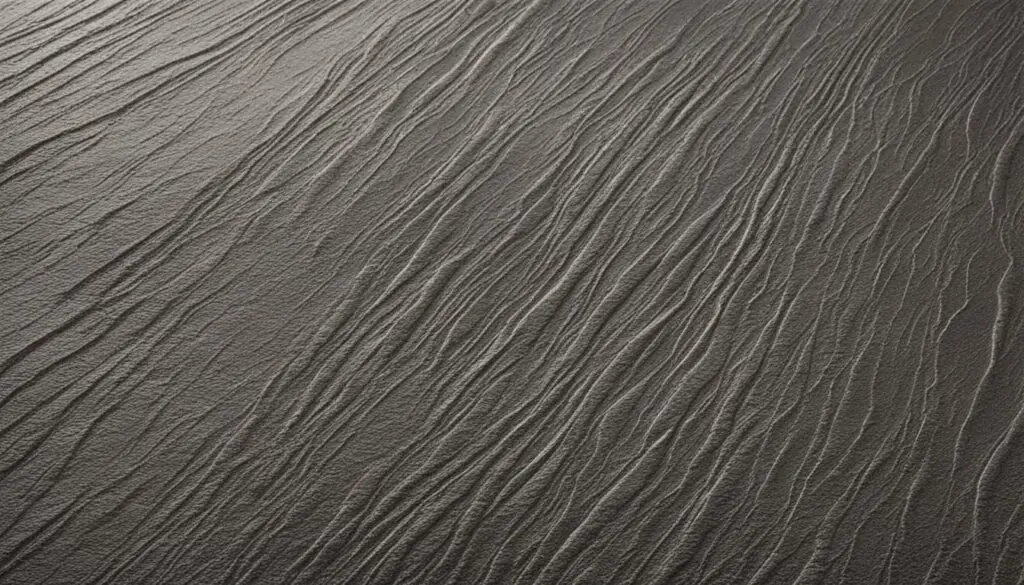
Description
The salt finish is especially revered for its distinct, pitted pattern that is subtle yet elegant, perfect for areas that demand extra foot traction without sacrificing style. It is achieved by embedding coarse rock salt crystals into wet concrete and later washing them away to reveal an uneven yet pleasantly textured surface. This finish is not only about its visual quality but also its functional prowess in reducing slip hazards, making it an ideal choice for pool surrounds, walkways, and public spaces.
Application Technique
The application process for a salt finish is relatively straightforward yet requires precise timing. Once the concrete surface is leveled and begins to set, a generous amount of rock salt is broadcast across the surface. Using a roller or float, the salt is then gently pressed into the partially hardened concrete. After allowing adequate setting time, the salt is washed off with water, which dissolves the salt to leave behind a beautiful, evenly pockmarked texture that is both gripping underfoot and visually captivating.
Advantage
What sets the salt finish apart is its inherent slip resistance. In my professional assessment, its perfectly embedded craters offer excellent traction, significantly reducing the risk of slipping when compared to smoother finishes. Additionally, the salt finish is versatile, complementing a wide range of exterior decors and landscape designs, and is less labor-intensive than some more intricate patterned finishes. The resulting textured concrete finish is not only functional but can also enhance the perceived value of a property.
Disadvantage
On the flip side, the salt finish is not without its drawbacks. Although the textured finish is captivating, it can occasionally catch debris, necessitating diligent maintenance to preserve its neat appearance. The uneven surface can make the cleaning process somewhat more challenging than smoother finishes. Furthermore, if not executed correctly, the uneven texture may lead to an inconsistent feeling underfoot which might be unsettling for some.
| Feature | Benefit | Consideration |
|---|---|---|
| Texture | Enhanced slip resistance | Potential for debris accumulation |
| Installation | Relatively simple, less labor-intensive | Requires precise timing and technique |
| Maintenance | Good durability | May require more frequent cleaning |
| Appearance | Aesthetically versatile | Can feel uneven underfoot if not done properly |
In conclusion, my exploration of the salt finish has led me to appreciate its unique blend of aesthetics and practicality. This textured concrete finish offers robust slip-resistant concrete solutions that are as much about safety as they are about beauty, making it a valued finish in my concrete repertoire.
Exposed Aggregate Finish: Beauty of Natural Stones
In my professional experience, the allure of exposed aggregate finish lies in its seamless integration of durability with the quintessential beauty of natural stone concrete. As we delve deep into this particular finish, we will uncover the attributes that make it a prized choice among decorative concrete finishes. Engaging with the exposed aggregate allows us to appreciate the charm and functionality embedded within.
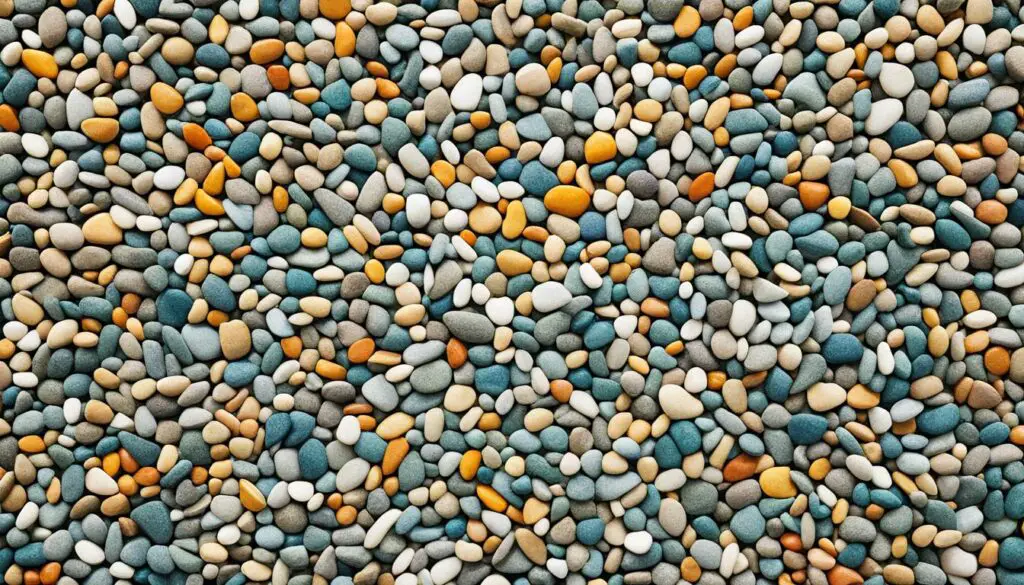
Description
At its core, an exposed aggregate finish is a celebration of concrete’s raw constituents. By removing the top layer of cement paste, the underlying aggregate—often comprised of pebbles, crushed stone, and sand—is revealed, creating a surface that’s rich in texture and robust in form. This finish not only presents an array of visual possibilities but also endorses concrete’s innate strength. The resulting floor is a tapestry of color and form, offering a touch of nature’s variegated palette in a solid, unyielding medium.
Installation Process
The installation of an exposed aggregate finish is a journey that requires precision, patience, and an understanding of concrete’s capricious nature. Initially, the concrete is poured and leveled, with the aggregate mixed within. After a brief curing period, the top layer is carefully washed away or treated with a surface retardant to prevent it from fully curing, thus allowing the aggregates to be exposed. It is this strategic interplay of timing and technique that unveils the natural stone concrete’s hidden gems.
Advantage
The advantages of such a finish are many. Its distinctive charm is immediately apparent, offering a rich, complex alternative to standard concrete surfaces. Furthermore, the inherent durability of the natural stone offers excellent resistance to heavy traffic and extreme weather conditions, ensuring that the beauty of an exposed aggregate finish endures over time. Additionally, its natural grip texture provides slip resistance, marrying safety with aesthetics.
Disadvantage
However, some considerations must be taken into account. The complexity of its installation process can require specialized skills and, as such, may result in higher labor costs. The need for precise timing during the exposure phase yields no room for error. Moreover, there exists an obligation for maintenance, as the uneven surface can collect dirt and require regular cleaning to maintain its pristine state and picturesque appearance.
As we navigate the intricate details of the exposed aggregate finish, we acknowledge its capacity to transform any space into a work of art that withstands the elements and the passage of time. Its rugged elegance, enshrined with the stones themselves, speaks to those who admire the enduring beauty of natural stone concrete set within the strength of a concrete matrix.
Swirl Finish Concrete: Unique Aesthetic
In the realm of decorative concrete, the swirl finish concrete stands out for its exceptional flair and uniqueness. Renowned for imbuing a distinctive character to landscapes and edifices, this decorative concrete technique employs a flowing pattern that captures the essence of movement in a solid state. Let’s delve into the intricacies of this unique concrete texture that brilliantly merges artistry with utility.
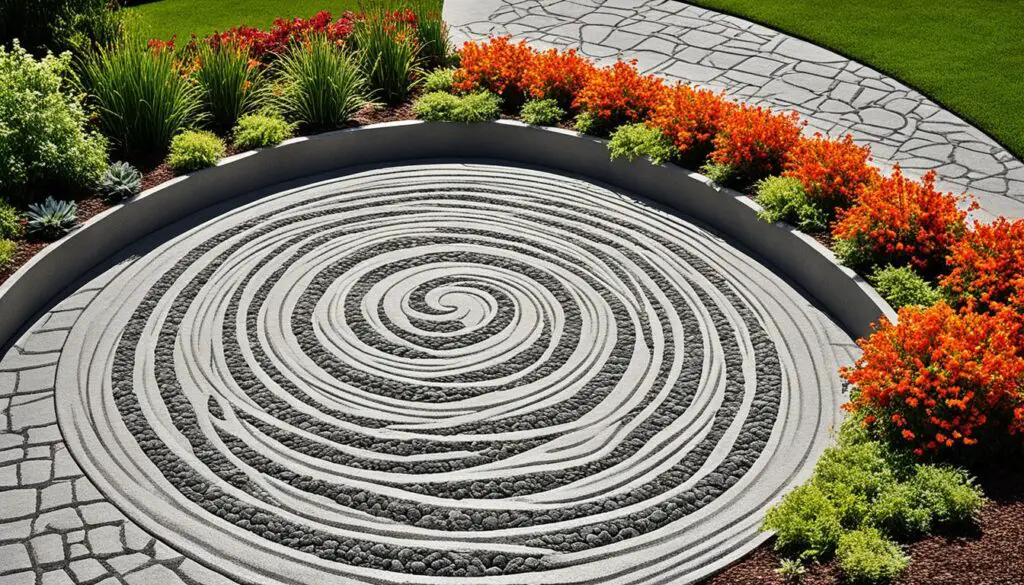
Description
The swirl finish concrete is a testament to the blending of artistic vision with construction expertise. Achieving this unique concrete texture involves a technique where the surface of wet concrete is worked into arcs and circles with a trowel, creating a pattern of arcs that are distinctive to each project. The visual result is a concrete canvas that bears a resemblance to natural phenomena, such as rippling water or the gentle sweep of a breeze over sand, making it a much-desired finish for those aiming to marry functionality with aesthetic charm.
Uses
My experience in the industry has shown me that swirl finish concrete is not only varied in its appearance but also highly versatile in its applications. This style is predominantly featured in:
- Garden pathways offer a hint of sophistication amidst natural greenery
- Outdoor patios, create an engaging space for relaxation and entertainment
- Public courtyards, where it brings artful flair to communal gathering spots
- Entryways, augment curb appeal and set a distinct ambiance from the first step
Advantage
The predominant advantage of this decorative concrete technique is the compelling aesthetic it provides. I’ve witnessed how a swirl finish can transform a plain concrete slab into a visually engaging surface that exemplifies custom craftsmanship. It adds organic texture and depth that can be tailored to harmonize with the surrounding environs or to stand out as a focal point within a design scheme.
Disadvantage
However, no technique is without its challenges. One notable disadvantage I’ve encountered with the swirl finish concrete is the necessity for skilled labor—with a perceptive eye for artistic detail—to execute the swirling pattern correctly. The timing during the concrete’s setting process is critical, and any miscalculations can lead to less-than-desirable results. Care must also be taken to ensure consistency across the entire surface, which requires precision and patience from the installer.
In summary, though it demands a specialized touch, the allure of swirl finish concrete lies in its ability to metamorphose a banal space into an artistic exploration. It exemplifies how unique concrete textures are influential in landscape architecture and design, transcending conventional expectations to offer something genuinely distinctive.
What Is the Cheapest Concrete Finish?
In my exploration of construction and design, I’ve observed that the cost can play a significant role in determining the type of concrete finish selected for a project. Discovering the cheapest concrete finish available offers an economical solution that can align with both the visual aspirations and budgetary restrictions of homeowners and builders. When it comes to choosing a finish that won’t break the bank but will still hold up over time, we’re looking at options that are as cost-effective as they are reliable.
One of the most economical concrete options is the broom finish. It entails a simple yet practical approach: dragging a broom across freshly poured concrete to create a uniform, textured surface. The materials required are minimal, the technique is straightforward, and the finish itself is durable and slip-resistant, making it a prime candidate for those pursuing a balance between economy and functionality. Additionally, the broom finish does not necessitate complex tools or extensive labor, which helps keep the costs down while still delivering a quality surface.
Seeking cost-effective concrete finishes doesn’t mean sacrificing esthetic appeal for affordability. A smooth-troweled finish, although slightly more labor-intensive than the broom finish, is still on the more economical side of the spectrum. This finish requires a basic troweling tool to smooth the concrete surface and can be performed relatively quickly. For those who are looking for a finer texture, a light steel trowel finish provides a more refined look without a steep increase in price, presenting an attractive yet budget-friendly alternative.
Ultimately, my professional advice for selecting the most affordable concrete finish is to consider long-term value as well as upfront costs. A finish that may appear cheap initially could demand more maintenance or sooner replacement, thereby affecting overall expenses. It’s about finding the sweet spot between price and performance – where durability meets dollar-saving decisions to culminate in a truly economical and effective concrete installation.
Thanks For the Great Attention!
Good Bye & Take Care
Happy Learning
Also, Read,

